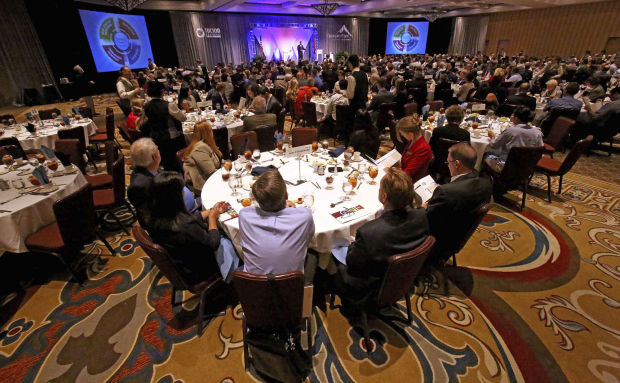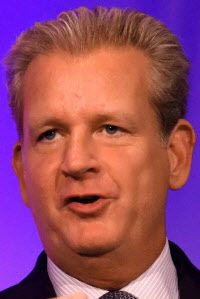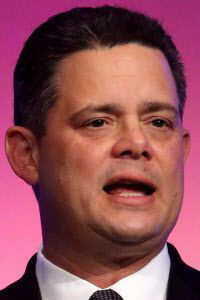Efforts to give Raytheon Missile Systems more room to grow in Tucson are critical to help the region’s biggest private employer thrive, the company’s president said Thursday.
With increasing global security threats, as well as global competition in the arms market, Raytheon needs flexibility — including space around its local operation at Tucson International Airport — to compete and grow, Missile Systems President Taylor Lawrence said at the annual luncheon of Tucson Regional Economic Opportunities Inc.
The world’s biggest missile maker, Raytheon develops and makes weapons including the Tomahawk cruise missile at its sprawling site at the airport, employing more than 9,000 people locally.
“One aspect of flexibility is the ability to expand in close proximity to existing operations, so we can affordably modernize when the time comes,” said Lawrence, who has headed Raytheon’s operation here since 2008. “It’s no secret ... one of our biggest concerns has been our ability to grow here in Tucson.”
In 2010, Raytheon passed on expanding in Tucson, choosing Huntsville, Alabama, as the site for a new, $75 million factory employing hundreds of people. That spurred ongoing efforts led by Pima County to improve access and create buffer areas around Raytheon’s airport site.
Lawrence noted that when billionaire Howard Hughes bought the airport-area property 60 years ago, it was “out away from the city with wide-open spaces so we could build missiles with a nice buffer zone around it.”
“But that open space is rapidly eroding,” he told the TREO luncheon crowd at the Hilton El Conquistador Golf & Tennis Resort. “That development around our airport site is a concern, because we need to have minimum distances to maintain a safe operating environment.”
Lawrence applauded efforts by the county to create an aerospace corridor south of the airport and a possible link with Interstate 10 and the University of Arizona Tech Park, where Raytheon also has significant operations.
On Tuesday, the Pima County Board of Supervisors approved planning for a proposed 15.6-mile southern link between I-10 and Interstate 19. The new corridor would hook up to the county’s proposed “aerospace parkway” south of the airport as part of a plan to realign Hughes Access Road to provide a buffer for future expansion of Raytheon.
Though Raytheon Missile Systems, like other defense employers, has shed hundreds of jobs in recent years through small layoffs and retirement attrition, Lawrence said the company remains committed to Tucson for the foreseeable future despite swirling rumors that Raytheon will exit the Old Pueblo.
“We have 4 million square feet here that we’re producing missiles out of, and we have a number of franchise programs that are supported here in Tucson. And as long as those are needed by our customers, we’ll continue to manufacture those in Tucson,” Lawrence said in an interview later Thursday. “As I’ve said, we’ll look at the right business decision when it comes to growth, and where we’re going to grow, and how we’ll grow. But the capabilities we have here in Tucson are a national treasure, and we don’t see that going away anytime soon.”
He cited the Tomahawk’s use in the current attacks on the Islamic State in Iraq and Syria, and the Advanced Medium-Range Air to Air Missile, which is widely used by the U.S. and its allies.
TREO President and CEO Joe Snell said the importance of Raytheon to the region’s economy can’t be overstressed.
“We have no greater asset in this region than Raytheon Missile Systems,” Snell said. “Raytheon is Southern Arizona’s largest employer, who frankly can dictate to a large degree the success or failure of this region.”
Snell said he invited Lawrence to keynote the TREO luncheon because “there’s a lot of rumors about what Raytheon needs or wants.”
‘Action-oriented’ plan
Recapping TREO’s activities, Snell noted that the mainly privately funded group recently completed a 10-month effort to develop an “action-oriented” plan for the region.
The new plan, updating a economic “blueprint” TREO developed in 2007, focuses on boosting talent as the top economic-development driver; infrastructure including links to Mexico and a proposed new Interstate 11; ensuring a pro-business environment; and a focus on health care both as an industry and as a key recruitment tool.
Snell said the TREO board also has authorized additional spending on sales and marketing, and he expects those wider efforts to pay off.
He said TREO’s pipeline of “qualified companies” — those targeted by TREO for their high value — has increased 54 percent in the last four years.
Notable additions and expansions, Snell said, include Duralar Technologies, an Italian nanotechnology company and developer of ultrahard coatings that set up its U.S. headquarters in Marana last spring; and expansions by Hydronalix, a Sahuarita-based maker of unmanned watercraft for rescue and reconnaissance; aerospace equipment maker Securaplane Technologies in Oro Valley; and Ascent Aviation Services at the airport.
“We’ve assisted more local companies than ever,” Snell said, noting that expansions of existing local companies typically account for 80 percent of job growth.
Snell noted that the local relocation and expansion of Shared Services Center, announced at the TREO lunch, was the result of the combined efforts of TREO, the Arizona Commerce Authority, Pima County, the city of Tucson, and real-estate brokers CBRE and Picor.
“We believe we have the assets to fully recover from the recession,” he said.








